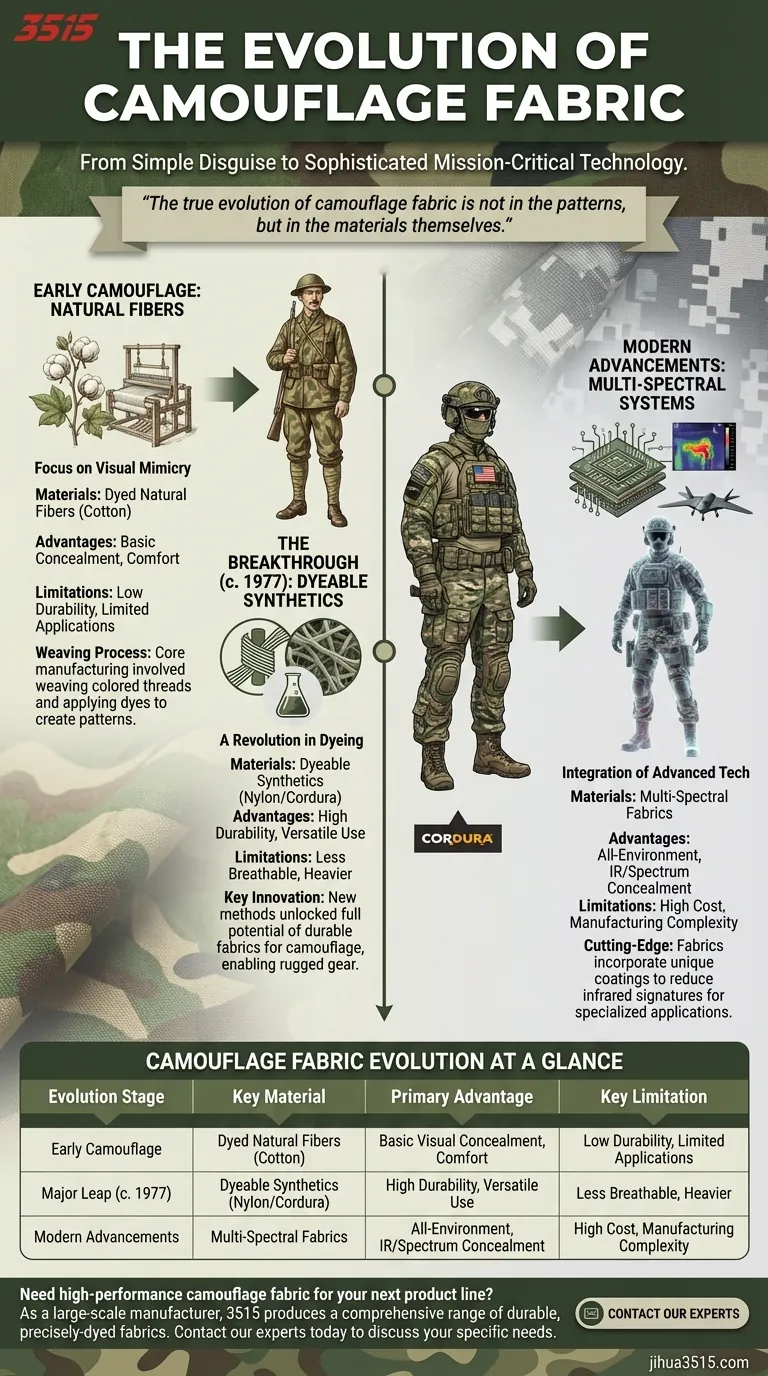The evolution of camouflage fabric is a story of material science, moving from simple dyed textiles to highly engineered synthetic systems. Initially, the focus was purely on visual mimicry, but advancements in materials like nylon and breakthroughs in dyeing processes paved the way for fabrics that offer not only concealment but also exceptional durability and the integration of advanced technologies.
The true evolution of camouflage fabric is not in the patterns, but in the materials themselves. The shift from natural fibers to durable, precisely-dyed synthetics like nylon was the critical turning point that enabled the creation of modern, multi-functional tactical gear.

From Natural Fibers to Synthetic Workhorses
The earliest forms of camouflage relied on basic principles applied to natural fabrics like cotton. The goal was simple: use dyes and patterns to break up an outline and blend into the environment.
The Foundational Weaving Process
The core manufacturing process has always involved weaving colored threads and applying dyes to create patterns that mimic natural surroundings. This requires a deep understanding of color combination and intricate weaving techniques to achieve a convincing effect.
The Introduction of Synthetics
The first major leap came with the introduction of synthetic fibers. Cordura, for example, was initially a type of rayon before it was re-engineered as a high-tenacity nylon fabric. This shift marked a significant move towards materials designed for ruggedness, not just appearance.
The Breakthrough: Making Synthetics Versatile
A durable fabric is only useful for camouflage if it can reliably hold a complex pattern. The inability to effectively dye early synthetics was a major roadblock.
A Revolution in Dyeing
A critical advancement occurred around 1977 when new methods were developed to dye nylon. This breakthrough was the key that unlocked the full potential of synthetic fabrics for military and outdoor applications.
Expanding the Applications
Once durable fabrics like Cordura could be effectively camouflaged, their use exploded. This innovation led directly to the creation of soft-sided, camouflaged luggage and gear that dominated the market, proving that durability and concealment could coexist in a single product.
Understanding the Trade-offs
The evolution of camouflage fabric has always involved balancing competing priorities. Modern advancements are no different and come with their own set of compromises.
Durability vs. Breathability
High-performance nylons offer incredible resistance to abrasion and tearing. However, they are often less breathable and heavier than the natural fibers they replaced, creating a trade-off between protection and user comfort.
Cost and Complexity
As fabrics incorporate more advanced features—from specialized dyes to unique coatings that reduce infrared signatures—their manufacturing complexity and cost increase significantly. The most advanced materials are often reserved for specialized applications where performance outweighs expense.
Pattern Specialization vs. Versatility
The ability to create highly specific patterns for every conceivable environment (e.g., desert, woodland, urban) is a major advantage. However, this specialization means a single pattern is often less effective when moved outside of its intended operational area, unlike the more generalized patterns of the past.
Matching the Fabric to the Goal
The "best" camouflage fabric is entirely dependent on its intended use. Understanding the evolutionary milestones helps clarify which type of material is suited for a specific need.
- If your primary focus is basic concealment and comfort: Traditional dyed natural fibers or simple synthetics are effective for visual blending in non-abrasive environments.
- If your primary focus is extreme durability for gear: The development of dyeable, high-tenacity nylons like Cordura represents the gold standard for load-bearing equipment, bags, and outerwear.
- If your primary focus is cutting-edge tactical advantage: Modern fabrics that incorporate technologies for multi-spectrum (e.g., visual and infrared) concealment are the pinnacle of camouflage evolution.
Ultimately, viewing camouflage fabric through the lens of material science reveals its transformation from a simple disguise into a sophisticated and mission-critical technology.
Summary Table:
| Evolution Stage | Key Material | Primary Advantage | Key Limitation |
|---|---|---|---|
| Early Camouflage | Dyed Natural Fibers (e.g., Cotton) | Basic Visual Concealment, Comfort | Low Durability, Limited Applications |
| Major Leap (c. 1977) | Dyeable Synthetics (e.g., Nylon/Cordura) | High Durability, Versatile Use | Less Breathable, Heavier |
| Modern Advancements | Multi-Spectral Fabrics | All-Environment, IR/Spectrum Concealment | High Cost, Manufacturing Complexity |
Need high-performance camouflage fabric for your next product line?
As a large-scale manufacturer, 3515 produces a comprehensive range of durable, precisely-dyed footwear and fabrics for distributors, brand owners, and bulk clients. Our expertise in advanced materials ensures your gear offers the perfect balance of concealment, durability, and comfort.
Contact our experts today to discuss your specific camouflage fabric needs and leverage our full production capabilities.
Visual Guide

Related Products
- Wholesale High-Traction Camo Boots - Custom Manufacturer for Brands
- Durable High-Traction Canvas Sneakers Wholesale & Custom Manufacturing
- Wholesale Durable Camo Canvas Shoes with High-Traction Rubber Soles
- Durable Canvas Work Shoes with Rubber Lug Sole | Wholesale Manufacturer
- Customizable Slip-On Safety Shoes Direct from the Factory for Wholesale
People Also Ask
- Are military camouflage boots waterproof? How to Choose Boots That Keep Feet Dry
- What are some real-world applications of military camouflage boots? From Tactical to Trendsetting
- How is PVC produced? From Salt & Gas to a Versatile Polymer
- What technologies are used in the men's 8-inch camo lace-up boots? A Guide to Rugged Outdoor Performance
- What are the key features of the new line of camo boots? Built for Extreme Cold & Rugged Terrain







